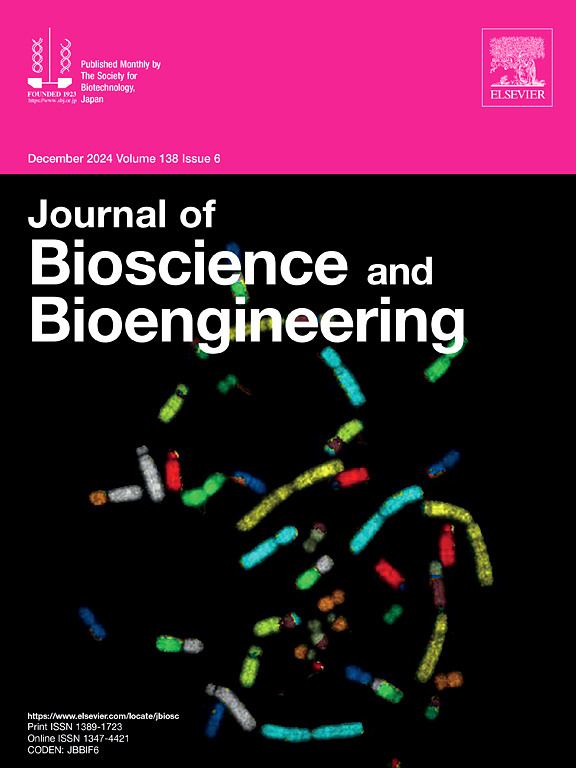早期添加多角Wickerhamiella在酱油发酵过程中促进香气形成的关键作用。
IF 2.9
4区 生物学
Q3 BIOTECHNOLOGY & APPLIED MICROBIOLOGY
引用次数: 0
摘要
在现代日本酱油生产中,密封的室外发酵罐被用来用耐盐发酵剂发酵森米:乳酸菌嗜盐四芽球菌和酵母多色Wickerhamiella multiis和Zygosaccharomyces rouxii。在发酵初期加入嗜盐乳杆菌和多面芽孢杆菌,而在1个月后加入柔氏弧菌开始酒精发酵。多面草和rouxii都有助于挥发性有机化合物(VOC)的产生,其中4-乙基愈创木酚(4-EG)是多面草独特产生的,是酱油特有香气所必需的。先前的宏基因组学和代谢组学分析表明,4-EG的产生发生在rouxii发酵之前,尽管多面霉的比例随后增加。另外一批产品的组学分析证实了类似的微生物和VOC动态,没有明确的关系增加和4-EG水平。为了研究这一点,进行了实验室规模的实验,使用过滤灭菌的森米上清作为培养基,交错接种两种酵母。活细胞密度、4-EG和乙醇作为发酵活性的指标。结果表明,在弧菌发酵前接种多面霉,4-EG的产生较早,而多面霉的细胞密度和乙醇产量只有在弧菌发酵开始后才有所增加。在这些条件下,4-EG和乙醇的产量最高,表明多面草的存在而不是增加对4-EG的产量至关重要。因此,早期添加多面草被认为是提高moromi中4-EG和VOC产量的有效策略。本文章由计算机程序翻译,如有差异,请以英文原文为准。
Crucial role of early addition of Wickerhamiella versatilis in enhancing aroma formation during soy sauce fermentation
In modern Japanese soy sauce production, sealed outdoor fermentation tanks are used to ferment moromi with halotolerant starter cultures: the lactic acid bacterium Tetragenococcus halophilus and yeasts Wickerhamiella versatilis and Zygosaccharomyces rouxii. T. halophilus and W. versatilis are added in the early fermentation stage, while Z. rouxii is introduced about 1 month later to initiate alcoholic fermentation. Both W. versatilis and Z. rouxii contribute to the production of volatile organic compounds (VOC), with 4-ethylguaiacol (4-EG), uniquely produced by W. versatilis, being essential for the characteristic aroma of soy sauce. Prior metagenomic and metabolomic analyses indicated that 4-EG production occurs prior to Z. rouxii fermentation, though the increase in W. versatilis proportion follows it. Additional omics analysis of a production batch confirmed similar microbial and VOC dynamics, with no clear relationship between W. versatilis increase and 4-EG levels. To investigate this, a laboratory-scale experiment was conducted using filter-sterilized moromi supernatant as a medium, with staggered inoculations of the two yeasts. Viable cell density, 4-EG, and ethanol were measured as indicators of fermentation activity. Results showed that when W. versatilis was inoculated before Z. rouxii, 4-EG production commenced earlier, while W. versatilis cell density and ethanol production increased only after Z. rouxii fermentation began. Under these conditions, 4-EG and ethanol production were highest, suggesting that the presence rather than the increase of W. versatilis is crucial for 4-EG production. Consequently, the early addition of W. versatilis was considered an effective strategy to enhance 4-EG and VOC production in moromi.
求助全文
通过发布文献求助,成功后即可免费获取论文全文。
去求助
来源期刊

Journal of bioscience and bioengineering
生物-生物工程与应用微生物
CiteScore
5.90
自引率
3.60%
发文量
144
审稿时长
51 days
期刊介绍:
The Journal of Bioscience and Bioengineering is a research journal publishing original full-length research papers, reviews, and Letters to the Editor. The Journal is devoted to the advancement and dissemination of knowledge concerning fermentation technology, biochemical engineering, food technology and microbiology.
 求助内容:
求助内容: 应助结果提醒方式:
应助结果提醒方式:


